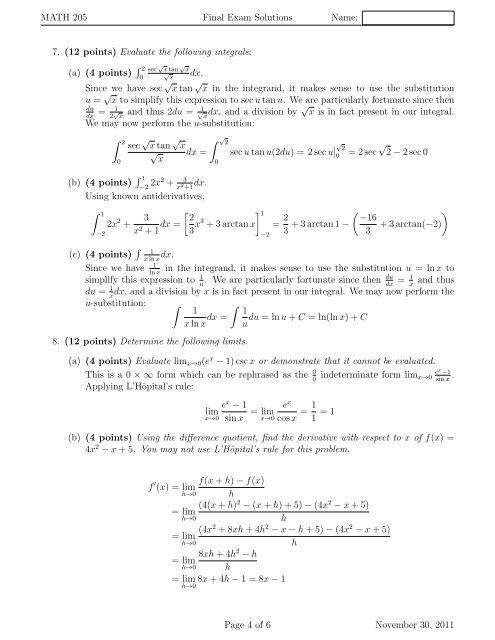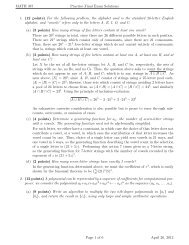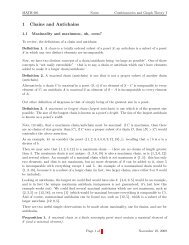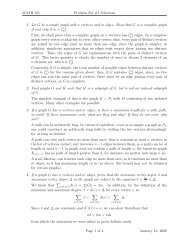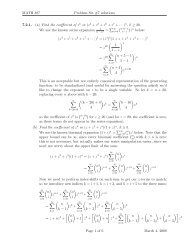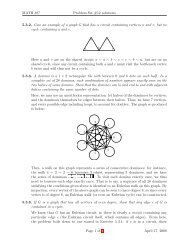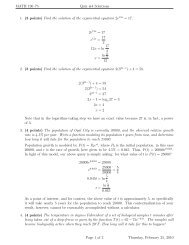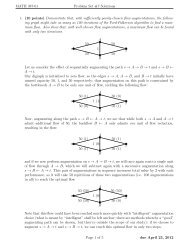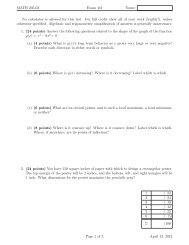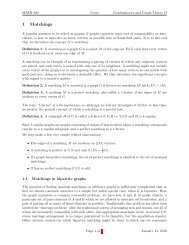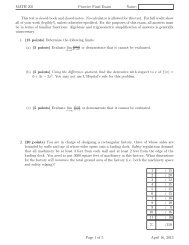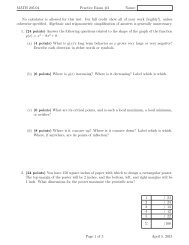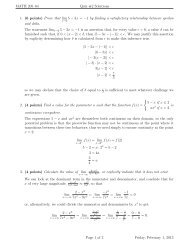MATH 205 Final Exam Solutions Name: 1. (12 points) The keratoid ...
MATH 205 Final Exam Solutions Name: 1. (12 points) The keratoid ...
MATH 205 Final Exam Solutions Name: 1. (12 points) The keratoid ...
Create successful ePaper yourself
Turn your PDF publications into a flip-book with our unique Google optimized e-Paper software.
<strong>MATH</strong> <strong>205</strong> <strong>Final</strong> <strong>Exam</strong> <strong>Solutions</strong> <strong>Name</strong>:<br />
7. (<strong>12</strong> <strong>points</strong>) Evaluate the following integrals:<br />
(a) (4 <strong>points</strong>) ∫ 2<br />
0<br />
sec √ x tan √ x<br />
√ x<br />
dx.<br />
Since we have sec √ x tan √ x in the integrand, it makes sense to use the substitution<br />
u = √ x to simplify this expression to sec u tan u. We are particularly fortunate since then<br />
du<br />
= 1<br />
dx 2 √ and thus 2du = √1<br />
x x<br />
dx, and a division by √ x is in fact present in our integral.<br />
We may now perform the u-substitution:<br />
∫ 2<br />
0<br />
sec √ x tan √ x<br />
√ x<br />
dx =<br />
(b) (4 <strong>points</strong>) ∫ 1<br />
−2 2x2 + 3<br />
x 2 +1 dx.<br />
Using known antiderivatives,<br />
∫ 1<br />
−2<br />
∫ √ 2<br />
0<br />
√<br />
sec u tan u(2du) = 2 sec u] 2<br />
0<br />
= 2 sec √ 2 − 2 sec 0<br />
2x 2 + 3 [ 1 2<br />
x 2 + 1 dx = 3 x3 + 3 arctan x]<br />
= 2 ( )<br />
−16<br />
−2<br />
3 + 3 arctan 1 − 3 + 3 arctan(−2)<br />
(c) (4 <strong>points</strong>) ∫ 1<br />
x ln x dx.<br />
1<br />
Since we have in the integrand, it makes sense to use the substitution u = ln x to<br />
ln x<br />
simplify this expression to 1 du<br />
. We are particularly fortunate since then = 1 and thus<br />
u dx x<br />
du = 1 dx, and a division by x is in fact present in our integral. We may now perform the<br />
x<br />
u-substitution: ∫<br />
∫<br />
1 1<br />
x ln x dx = du = ln u + C = ln(ln x) + C<br />
u<br />
8. (<strong>12</strong> <strong>points</strong>) Determine the following limits.<br />
(a) (4 <strong>points</strong>) Evaluate lim x→0 (e x − 1) csc x or demonstrate that it cannot be evaluated.<br />
This is a 0 × ∞ form which can be rephrased as the 0 indeterminate form lim 0 x→0 ex −1<br />
. sin x<br />
Applying L’Hôpital’s rule:<br />
e x − 1<br />
lim<br />
x→0 sin x = lim e x<br />
x→0 cos x = 1 1 = 1<br />
(b) (4 <strong>points</strong>) Using the difference quotient, find the derivative with respect to x of f(x) =<br />
4x 2 − x + 5. You may not use L’Hôpital’s rule for this problem.<br />
f ′ (x) = lim<br />
h→0<br />
f(x + h) − f(x)<br />
h<br />
(4(x + h) 2 − (x + h) + 5) − (4x 2 − x + 5)<br />
= lim<br />
h→0 h<br />
(4x 2 + 8xh + 4h 2 − x − h + 5) − (4x 2 − x + 5)<br />
= lim<br />
h→0 h<br />
8xh + 4h 2 − h<br />
= lim<br />
h→0 h<br />
= lim 8x + 4h − 1 = 8x − 1<br />
h→0<br />
Page 4 of 6 November 30, 2011


